From the credit report fraudster who enabled one of the largest identity theft scams in US history, to the criminal who used the stolen identities of American emigrant children to fraudulently apply for loans, open credit cards and buy properties, identity theft is a real-life horror story for many people.
In fact, the Federal Trade Commission (FTC) reported more than $10 billion lost to fraud in the US in 2023, with 25% of all cases (approximately 1.4 million) classified as instances of identity theft. But what happens when someone steals your identity — and what does it mean for you? In this article, we explore how different types of identity theft scams work and explain what you should do to protect your personal information.
How do identity theft scams work?
Identity theft occurs when someone steals your personal information, such as your name, address, date of birth, credit card details and social security number, so they can use your identity. There are a range of ways in which criminals can steal your personal identifying information (PII), including:
Accessing online accounts with poor security
Purchases made on fake online shopping websites
Emotional manipulation via imposter scams
Data breaches and leaks
Hacking public Wi-Fi networks
Bought on the dark web
Accessing devices via malware
5 most common types of identity theft scams
In 2023, victims of fraud filed more reports to the FTC about identity theft scams than any other type of complaint — and there are a range of ways criminals use stolen PII to make money.
1. Credit card fraud
In the US, 40% of all identity theft complaints are credit card-related — making it the most common type of ID fraud. Credit card fraud is when criminals make purchases in your name using an existing account or by opening new accounts — and racking up charges — in your name. Fortunately, many countries have legislation in place to safeguard consumers from liability for unauthorized charges — for example, the Fair Credit Billing Act in the US protects consumers from liability over $50, with some issuers offering $0 liability. However, it can take months for issuers to investigate credit card fraud and restore lost credit.
How do scammers get your credit card information?
Theft of a physical card or placing “skimmers” on ATMs or card readers to clone your card.
Web skimming, whereby a criminal steals personal data from a website by placing malicious malware or code into the site that captures any information that users input into forms.
Account takeover, whereby a criminal contacts your credit provider using your personal information to change PINs, passwords and addresses, and lock you out of the account.
“Card not present” theft, whereby a criminal obtains your credit card information through phishing, a data breach, or the dark web.
2. Loan or lease fraud
Loan or lease fraud accounts for 14% of all identity theft complaints in the US. As the name suggests, it’s when criminals take out loans and leases, such as payday loans, mortgage and business loans or rental leases, using your personal information. Agencies require minimal information (such as social security numbers and bank account information) during the screening process and identity thieves take advantage of this — knowing their victims will be held responsible for any loans.
How do scammers get your personal information?
Tricking you into inputting your data via phishing scams.
Accessing your device via downloaded malware.
Buying your breached or leaked data on the dark web.
3. Bank account fraud
Making up 13% of US identity theft complaints, bank account fraud is when criminals make unauthorized transactions using your bank account information. If your bank statement shows purchases that you haven’t made, report it to your bank and they will cancel your card right away so no more money can be taken. Banks should also refund any money stolen as a result of identity theft — it may, however, be more difficult to get money back if you authorized a payment in a scam.
How do scammers get your bank account information?
Vishing calls pretending to be your bank and asking for information.
Obtaining your details through data breaches or bought on the dark web.
Stealing bank account details input into websites through web skimming.
ATM scams, whereby criminals tamper with machines.
4. Government documents or benefits fraud
Just over 9% of US identity theft complaints are about illegally obtained or fake government documents and falsely claimed government benefits. The most common type of benefits fraud is providing false information to claim benefits — and that’s where identity thieves find opportunity. After stealing personal information such as names and social security numbers, criminals then submit fraudulent applications for disability benefits or housing benefits posing as their victims.
How do scammers get your personal information?
Tricking you into inputting your data via phishing scams.
Accessing your device via downloaded malware.
Buying your breached or leaked data on the dark web.
5. Employment or tax-related fraud
Around 8.5% of identity theft complaints in the US relate to employment or tax fraud. Employment fraud is when criminals pose as recruitment agents and hire you for a job that doesn’t exist, while tax fraud is when someone fails to file their tax return or claims false amounts or expenses. One type of employment fraud which has risen in popularity in recent years is job scams on LinkedIn, whereby criminals trick job seekers into providing their personal information during fake onboarding processes.
How do employment scams work?
Fake job postings: the “interview” process is managed virtually and then data is collected from the candidate during the “onboarding” process. Once the scammer receives this, they disappear.
Fake recruiter profiles: the scammer poses as a recruiter to establish relationships with LinkedIn job seekers. Promising a job referral or application, they collect users’ personal information.
Fake investor opportunities: after creating a fake company and website, scammers message real LinkedIn profiles with a rare opportunity to earn money — asking for a fee to secure their stake.
How to protect your identity from thieves
Identity theft scams can play out in many ways — but that also means there are many things you can do to reduce the risk of losing your personal information to them.
Use strong and unique passwords across your online accounts.
Enable two-factor authentication and opt for an authenticator app over SMS authentication.
Verify the authenticity of a sender before clicking links in emails, SMS, and instant messages.
Use a VPN when you access public Wi‑Fi networks.
Monitor your email addresses for breaches in a security app.
What to do if you fall victim to identity theft
If you suspect that your identity has been stolen, follow these steps to mitigate any financial losses:
Change your passwords and any similar passwords for other online accounts.
Report stolen credit and debit card details or any unusual transactions to your bank and/or credit card company.
Delete any bank or credit card details stored in online services (such as Amazon).
Contact your country’s fraud protection service — FTC in the US, CIFAS in the UK, or notify the police if you live in an EU country such as Finland, Germany, and Sweden.
Contact one of your country’s major credit reporting agencies, such as Experian, Equifax or TransUnion in the US and UK, to place a credit freeze on your file and request fraud alerts.



)



